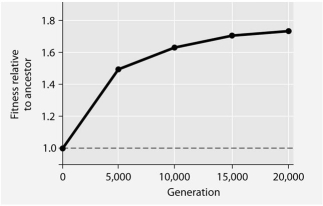Question 51
(Multiple Choice)
The following questions refer to the information and figure below.
In this eight-year experiment,12 populations of E.coli,each begun from a single cell,were grown in low-glucose conditions for 20 000 generations.Each culture was introduced to fresh growth medium every 24 hours.Occasionally,samples were removed from the populations,and their fitness in low-glucose conditions was tested against that of members sampled from the ancestral (common ancestor)E.coli population.

-Which of the following,if it occurs in the absence of any other type of adaptation listed here,is least reasonable in terms of promoting bacterial survival over evolutionary time in a low-glucose environment?
A)increased efficiency at transporting glucose into the cell from the environment
B)increased ability to survive on simple sugars other than glucose
C)increased ability to synthesize glucose from amino acid precursors
D)increased reliance on glycolytic enzymes
E)increased sensitivity to, and ability to move toward, whatever glucose is present in its habitat
Answer